Assessment 2: Collaborative Mental Health Nursing Practice Report
VerifiedAdded on 2022/10/11
|11
|3016
|7
Report
AI Summary
This report delves into collaborative mental health nursing, emphasizing the crucial role of understanding the patient's experience. It begins by defining key terms such as collaborative nurse-consumer relationships, mental health, and patient-centered care, setting the stage for an examination of how nurses can gain insight into patients' experiences through various methods, including maintaining human relationships, engaging in negotiated dialogues, and maneuvering services and contacts. The report highlights the importance of communication skills and the impact of effective communication on building trust, fostering patient empowerment, and enhancing the nurse-consumer relationship. It also reflects on the author's personal experience in a psychiatric hospital, identifying areas for improvement in communication skills. The report further stresses the significance of collaborative practice, the need for nurses to gain an understanding of their patient's experiences, and the role of hospital managers in supporting successful nurse-consumer relationships. The report concludes by underscoring the need for both nurses and consumers to review their practices to establish a successful collaborative partnership.

Collaborative Practice PAGE1
Collaborative Practice with Experts by Experience
By (Name)
The Name of the Class
Professor
The Name of the School
The City and State
The Date
Collaborative Practice with Experts by Experience
By (Name)
The Name of the Class
Professor
The Name of the School
The City and State
The Date
Paraphrase This Document
Need a fresh take? Get an instant paraphrase of this document with our AI Paraphraser
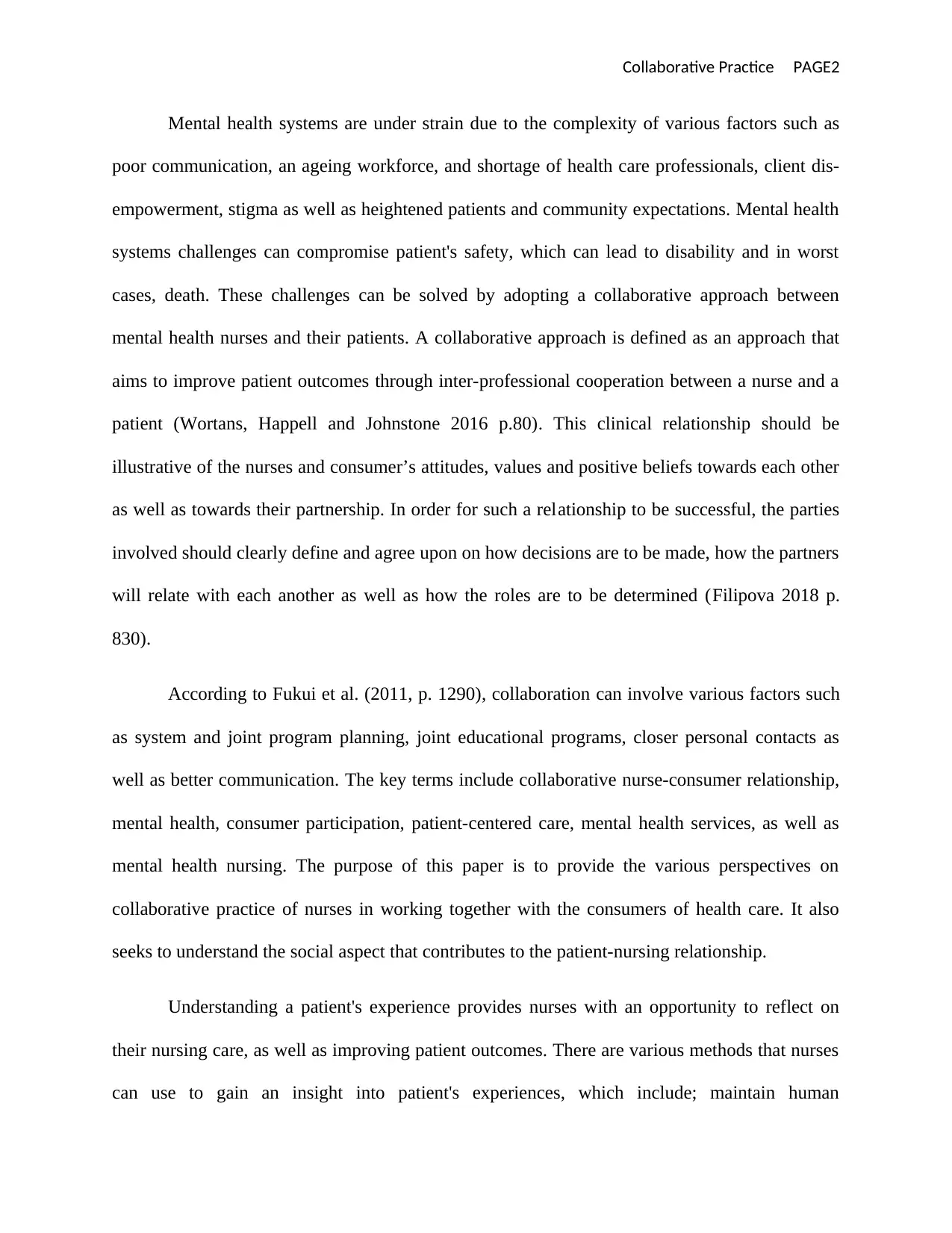
Collaborative Practice PAGE2
Mental health systems are under strain due to the complexity of various factors such as
poor communication, an ageing workforce, and shortage of health care professionals, client dis-
empowerment, stigma as well as heightened patients and community expectations. Mental health
systems challenges can compromise patient's safety, which can lead to disability and in worst
cases, death. These challenges can be solved by adopting a collaborative approach between
mental health nurses and their patients. A collaborative approach is defined as an approach that
aims to improve patient outcomes through inter-professional cooperation between a nurse and a
patient (Wortans, Happell and Johnstone 2016 p.80). This clinical relationship should be
illustrative of the nurses and consumer’s attitudes, values and positive beliefs towards each other
as well as towards their partnership. In order for such a relationship to be successful, the parties
involved should clearly define and agree upon on how decisions are to be made, how the partners
will relate with each another as well as how the roles are to be determined (Filipova 2018 p.
830).
According to Fukui et al. (2011, p. 1290), collaboration can involve various factors such
as system and joint program planning, joint educational programs, closer personal contacts as
well as better communication. The key terms include collaborative nurse-consumer relationship,
mental health, consumer participation, patient-centered care, mental health services, as well as
mental health nursing. The purpose of this paper is to provide the various perspectives on
collaborative practice of nurses in working together with the consumers of health care. It also
seeks to understand the social aspect that contributes to the patient-nursing relationship.
Understanding a patient's experience provides nurses with an opportunity to reflect on
their nursing care, as well as improving patient outcomes. There are various methods that nurses
can use to gain an insight into patient's experiences, which include; maintain human
Mental health systems are under strain due to the complexity of various factors such as
poor communication, an ageing workforce, and shortage of health care professionals, client dis-
empowerment, stigma as well as heightened patients and community expectations. Mental health
systems challenges can compromise patient's safety, which can lead to disability and in worst
cases, death. These challenges can be solved by adopting a collaborative approach between
mental health nurses and their patients. A collaborative approach is defined as an approach that
aims to improve patient outcomes through inter-professional cooperation between a nurse and a
patient (Wortans, Happell and Johnstone 2016 p.80). This clinical relationship should be
illustrative of the nurses and consumer’s attitudes, values and positive beliefs towards each other
as well as towards their partnership. In order for such a relationship to be successful, the parties
involved should clearly define and agree upon on how decisions are to be made, how the partners
will relate with each another as well as how the roles are to be determined (Filipova 2018 p.
830).
According to Fukui et al. (2011, p. 1290), collaboration can involve various factors such
as system and joint program planning, joint educational programs, closer personal contacts as
well as better communication. The key terms include collaborative nurse-consumer relationship,
mental health, consumer participation, patient-centered care, mental health services, as well as
mental health nursing. The purpose of this paper is to provide the various perspectives on
collaborative practice of nurses in working together with the consumers of health care. It also
seeks to understand the social aspect that contributes to the patient-nursing relationship.
Understanding a patient's experience provides nurses with an opportunity to reflect on
their nursing care, as well as improving patient outcomes. There are various methods that nurses
can use to gain an insight into patient's experiences, which include; maintain human
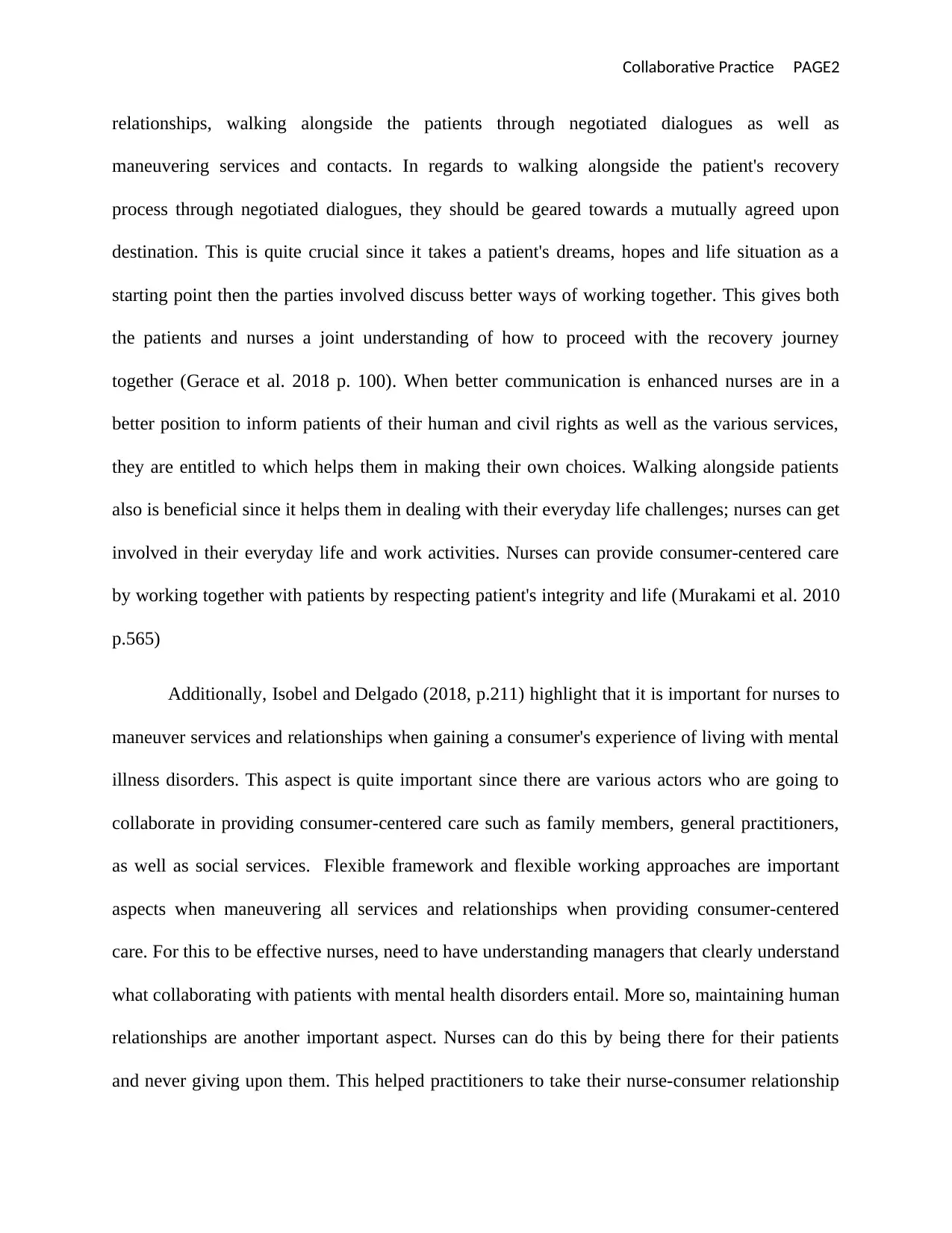
Collaborative Practice PAGE2
relationships, walking alongside the patients through negotiated dialogues as well as
maneuvering services and contacts. In regards to walking alongside the patient's recovery
process through negotiated dialogues, they should be geared towards a mutually agreed upon
destination. This is quite crucial since it takes a patient's dreams, hopes and life situation as a
starting point then the parties involved discuss better ways of working together. This gives both
the patients and nurses a joint understanding of how to proceed with the recovery journey
together (Gerace et al. 2018 p. 100). When better communication is enhanced nurses are in a
better position to inform patients of their human and civil rights as well as the various services,
they are entitled to which helps them in making their own choices. Walking alongside patients
also is beneficial since it helps them in dealing with their everyday life challenges; nurses can get
involved in their everyday life and work activities. Nurses can provide consumer-centered care
by working together with patients by respecting patient's integrity and life (Murakami et al. 2010
p.565)
Additionally, Isobel and Delgado (2018, p.211) highlight that it is important for nurses to
maneuver services and relationships when gaining a consumer's experience of living with mental
illness disorders. This aspect is quite important since there are various actors who are going to
collaborate in providing consumer-centered care such as family members, general practitioners,
as well as social services. Flexible framework and flexible working approaches are important
aspects when maneuvering all services and relationships when providing consumer-centered
care. For this to be effective nurses, need to have understanding managers that clearly understand
what collaborating with patients with mental health disorders entail. More so, maintaining human
relationships are another important aspect. Nurses can do this by being there for their patients
and never giving upon them. This helped practitioners to take their nurse-consumer relationship
relationships, walking alongside the patients through negotiated dialogues as well as
maneuvering services and contacts. In regards to walking alongside the patient's recovery
process through negotiated dialogues, they should be geared towards a mutually agreed upon
destination. This is quite crucial since it takes a patient's dreams, hopes and life situation as a
starting point then the parties involved discuss better ways of working together. This gives both
the patients and nurses a joint understanding of how to proceed with the recovery journey
together (Gerace et al. 2018 p. 100). When better communication is enhanced nurses are in a
better position to inform patients of their human and civil rights as well as the various services,
they are entitled to which helps them in making their own choices. Walking alongside patients
also is beneficial since it helps them in dealing with their everyday life challenges; nurses can get
involved in their everyday life and work activities. Nurses can provide consumer-centered care
by working together with patients by respecting patient's integrity and life (Murakami et al. 2010
p.565)
Additionally, Isobel and Delgado (2018, p.211) highlight that it is important for nurses to
maneuver services and relationships when gaining a consumer's experience of living with mental
illness disorders. This aspect is quite important since there are various actors who are going to
collaborate in providing consumer-centered care such as family members, general practitioners,
as well as social services. Flexible framework and flexible working approaches are important
aspects when maneuvering all services and relationships when providing consumer-centered
care. For this to be effective nurses, need to have understanding managers that clearly understand
what collaborating with patients with mental health disorders entail. More so, maintaining human
relationships are another important aspect. Nurses can do this by being there for their patients
and never giving upon them. This helped practitioners to take their nurse-consumer relationship
⊘ This is a preview!⊘
Do you want full access?
Subscribe today to unlock all pages.

Trusted by 1+ million students worldwide
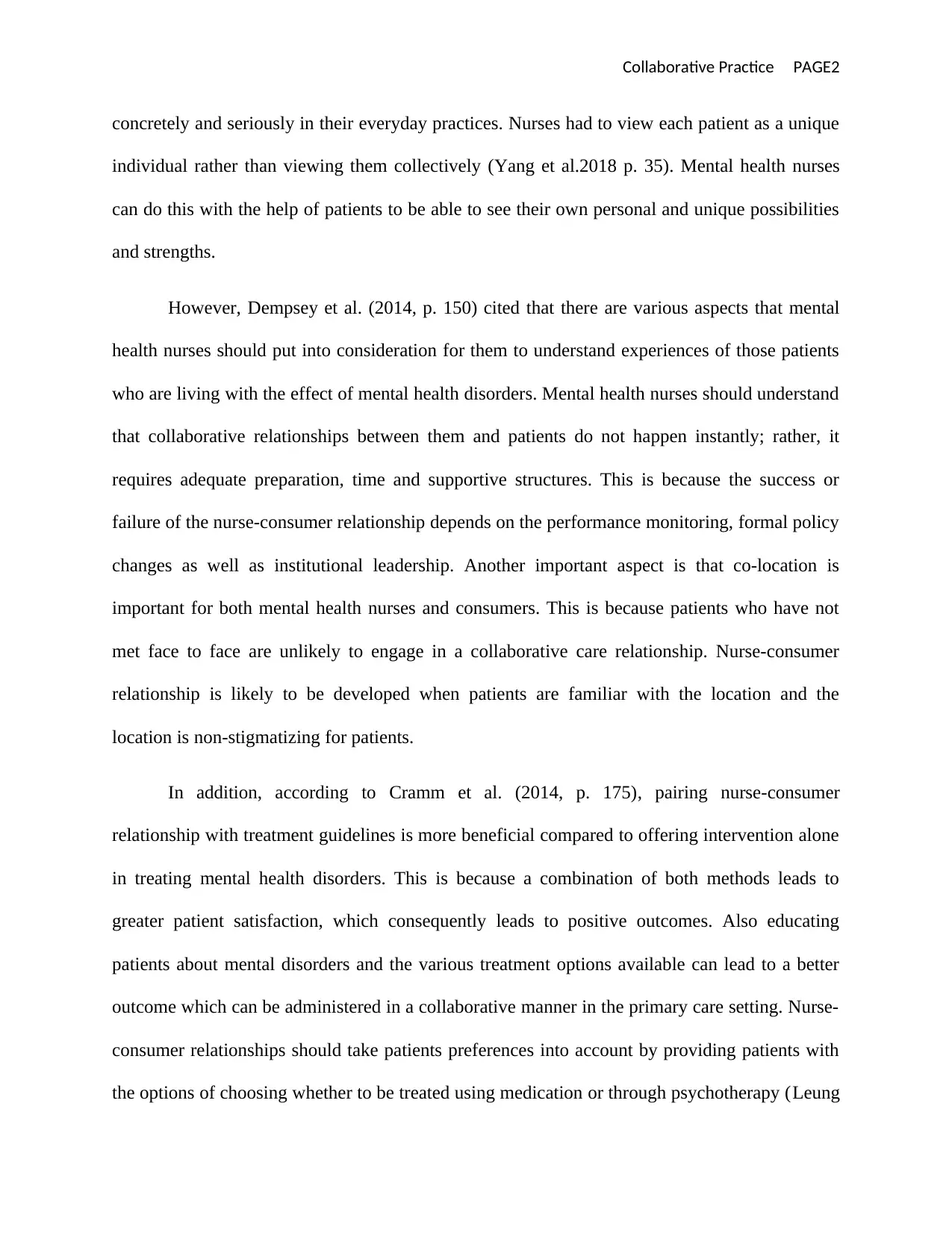
Collaborative Practice PAGE2
concretely and seriously in their everyday practices. Nurses had to view each patient as a unique
individual rather than viewing them collectively (Yang et al.2018 p. 35). Mental health nurses
can do this with the help of patients to be able to see their own personal and unique possibilities
and strengths.
However, Dempsey et al. (2014, p. 150) cited that there are various aspects that mental
health nurses should put into consideration for them to understand experiences of those patients
who are living with the effect of mental health disorders. Mental health nurses should understand
that collaborative relationships between them and patients do not happen instantly; rather, it
requires adequate preparation, time and supportive structures. This is because the success or
failure of the nurse-consumer relationship depends on the performance monitoring, formal policy
changes as well as institutional leadership. Another important aspect is that co-location is
important for both mental health nurses and consumers. This is because patients who have not
met face to face are unlikely to engage in a collaborative care relationship. Nurse-consumer
relationship is likely to be developed when patients are familiar with the location and the
location is non-stigmatizing for patients.
In addition, according to Cramm et al. (2014, p. 175), pairing nurse-consumer
relationship with treatment guidelines is more beneficial compared to offering intervention alone
in treating mental health disorders. This is because a combination of both methods leads to
greater patient satisfaction, which consequently leads to positive outcomes. Also educating
patients about mental disorders and the various treatment options available can lead to a better
outcome which can be administered in a collaborative manner in the primary care setting. Nurse-
consumer relationships should take patients preferences into account by providing patients with
the options of choosing whether to be treated using medication or through psychotherapy (Leung
concretely and seriously in their everyday practices. Nurses had to view each patient as a unique
individual rather than viewing them collectively (Yang et al.2018 p. 35). Mental health nurses
can do this with the help of patients to be able to see their own personal and unique possibilities
and strengths.
However, Dempsey et al. (2014, p. 150) cited that there are various aspects that mental
health nurses should put into consideration for them to understand experiences of those patients
who are living with the effect of mental health disorders. Mental health nurses should understand
that collaborative relationships between them and patients do not happen instantly; rather, it
requires adequate preparation, time and supportive structures. This is because the success or
failure of the nurse-consumer relationship depends on the performance monitoring, formal policy
changes as well as institutional leadership. Another important aspect is that co-location is
important for both mental health nurses and consumers. This is because patients who have not
met face to face are unlikely to engage in a collaborative care relationship. Nurse-consumer
relationship is likely to be developed when patients are familiar with the location and the
location is non-stigmatizing for patients.
In addition, according to Cramm et al. (2014, p. 175), pairing nurse-consumer
relationship with treatment guidelines is more beneficial compared to offering intervention alone
in treating mental health disorders. This is because a combination of both methods leads to
greater patient satisfaction, which consequently leads to positive outcomes. Also educating
patients about mental disorders and the various treatment options available can lead to a better
outcome which can be administered in a collaborative manner in the primary care setting. Nurse-
consumer relationships should take patients preferences into account by providing patients with
the options of choosing whether to be treated using medication or through psychotherapy (Leung
Paraphrase This Document
Need a fresh take? Get an instant paraphrase of this document with our AI Paraphraser
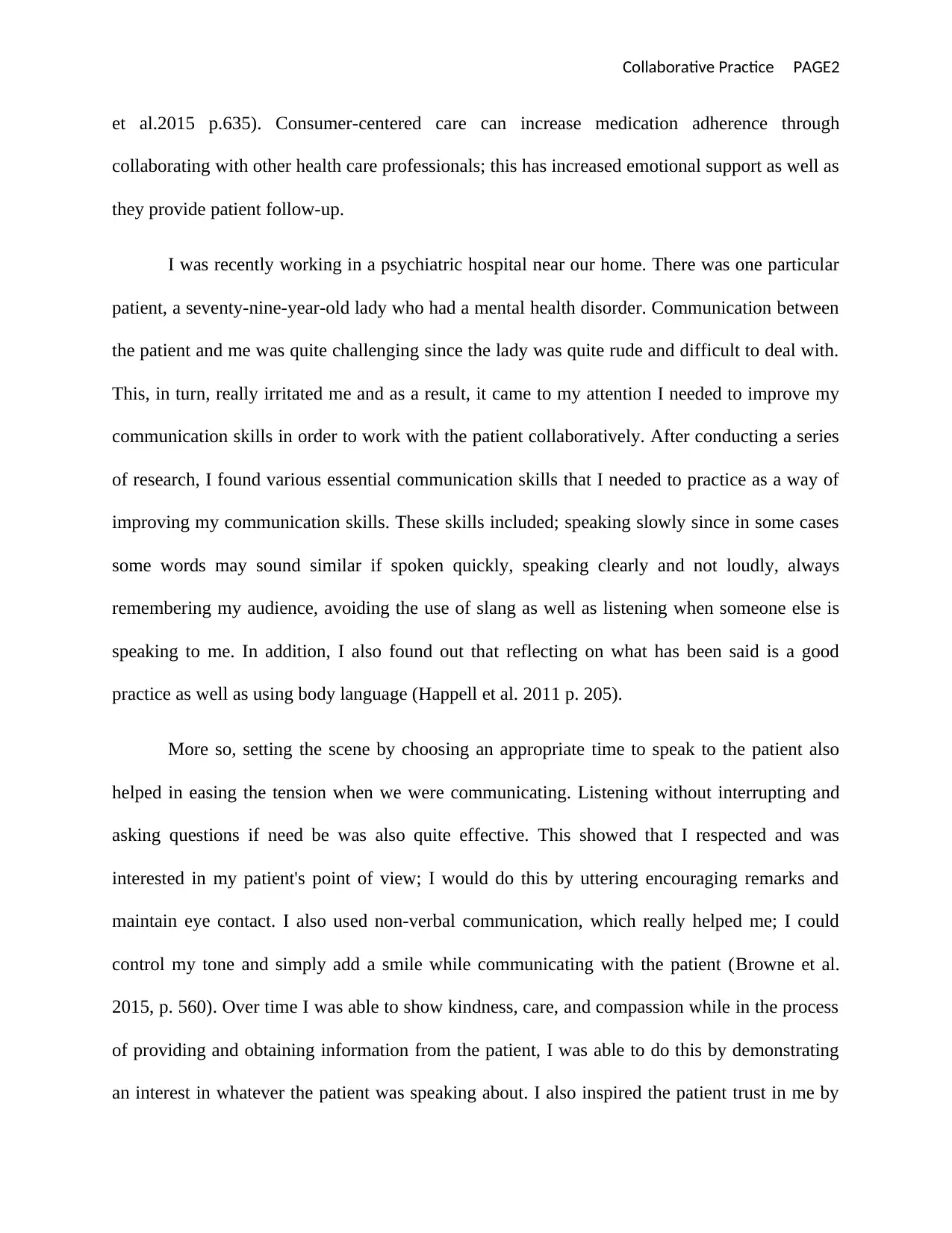
Collaborative Practice PAGE2
et al.2015 p.635). Consumer-centered care can increase medication adherence through
collaborating with other health care professionals; this has increased emotional support as well as
they provide patient follow-up.
I was recently working in a psychiatric hospital near our home. There was one particular
patient, a seventy-nine-year-old lady who had a mental health disorder. Communication between
the patient and me was quite challenging since the lady was quite rude and difficult to deal with.
This, in turn, really irritated me and as a result, it came to my attention I needed to improve my
communication skills in order to work with the patient collaboratively. After conducting a series
of research, I found various essential communication skills that I needed to practice as a way of
improving my communication skills. These skills included; speaking slowly since in some cases
some words may sound similar if spoken quickly, speaking clearly and not loudly, always
remembering my audience, avoiding the use of slang as well as listening when someone else is
speaking to me. In addition, I also found out that reflecting on what has been said is a good
practice as well as using body language (Happell et al. 2011 p. 205).
More so, setting the scene by choosing an appropriate time to speak to the patient also
helped in easing the tension when we were communicating. Listening without interrupting and
asking questions if need be was also quite effective. This showed that I respected and was
interested in my patient's point of view; I would do this by uttering encouraging remarks and
maintain eye contact. I also used non-verbal communication, which really helped me; I could
control my tone and simply add a smile while communicating with the patient (Browne et al.
2015, p. 560). Over time I was able to show kindness, care, and compassion while in the process
of providing and obtaining information from the patient, I was able to do this by demonstrating
an interest in whatever the patient was speaking about. I also inspired the patient trust in me by
et al.2015 p.635). Consumer-centered care can increase medication adherence through
collaborating with other health care professionals; this has increased emotional support as well as
they provide patient follow-up.
I was recently working in a psychiatric hospital near our home. There was one particular
patient, a seventy-nine-year-old lady who had a mental health disorder. Communication between
the patient and me was quite challenging since the lady was quite rude and difficult to deal with.
This, in turn, really irritated me and as a result, it came to my attention I needed to improve my
communication skills in order to work with the patient collaboratively. After conducting a series
of research, I found various essential communication skills that I needed to practice as a way of
improving my communication skills. These skills included; speaking slowly since in some cases
some words may sound similar if spoken quickly, speaking clearly and not loudly, always
remembering my audience, avoiding the use of slang as well as listening when someone else is
speaking to me. In addition, I also found out that reflecting on what has been said is a good
practice as well as using body language (Happell et al. 2011 p. 205).
More so, setting the scene by choosing an appropriate time to speak to the patient also
helped in easing the tension when we were communicating. Listening without interrupting and
asking questions if need be was also quite effective. This showed that I respected and was
interested in my patient's point of view; I would do this by uttering encouraging remarks and
maintain eye contact. I also used non-verbal communication, which really helped me; I could
control my tone and simply add a smile while communicating with the patient (Browne et al.
2015, p. 560). Over time I was able to show kindness, care, and compassion while in the process
of providing and obtaining information from the patient, I was able to do this by demonstrating
an interest in whatever the patient was speaking about. I also inspired the patient trust in me by
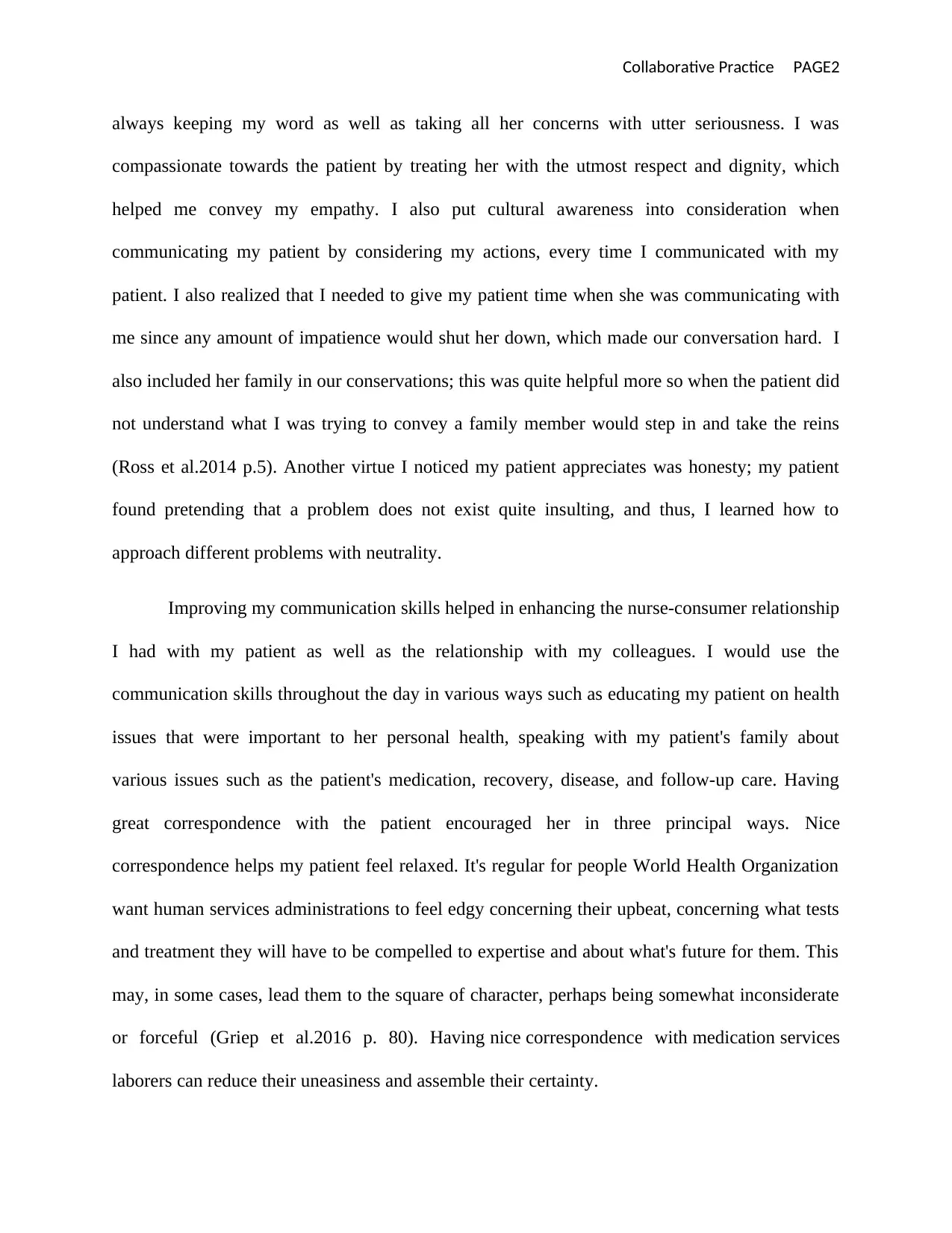
Collaborative Practice PAGE2
always keeping my word as well as taking all her concerns with utter seriousness. I was
compassionate towards the patient by treating her with the utmost respect and dignity, which
helped me convey my empathy. I also put cultural awareness into consideration when
communicating my patient by considering my actions, every time I communicated with my
patient. I also realized that I needed to give my patient time when she was communicating with
me since any amount of impatience would shut her down, which made our conversation hard. I
also included her family in our conservations; this was quite helpful more so when the patient did
not understand what I was trying to convey a family member would step in and take the reins
(Ross et al.2014 p.5). Another virtue I noticed my patient appreciates was honesty; my patient
found pretending that a problem does not exist quite insulting, and thus, I learned how to
approach different problems with neutrality.
Improving my communication skills helped in enhancing the nurse-consumer relationship
I had with my patient as well as the relationship with my colleagues. I would use the
communication skills throughout the day in various ways such as educating my patient on health
issues that were important to her personal health, speaking with my patient's family about
various issues such as the patient's medication, recovery, disease, and follow-up care. Having
great correspondence with the patient encouraged her in three principal ways. Nice
correspondence helps my patient feel relaxed. It's regular for people World Health Organization
want human services administrations to feel edgy concerning their upbeat, concerning what tests
and treatment they will have to be compelled to expertise and about what's future for them. This
may, in some cases, lead them to the square of character, perhaps being somewhat inconsiderate
or forceful (Griep et al.2016 p. 80). Having nice correspondence with medication services
laborers can reduce their uneasiness and assemble their certainty.
always keeping my word as well as taking all her concerns with utter seriousness. I was
compassionate towards the patient by treating her with the utmost respect and dignity, which
helped me convey my empathy. I also put cultural awareness into consideration when
communicating my patient by considering my actions, every time I communicated with my
patient. I also realized that I needed to give my patient time when she was communicating with
me since any amount of impatience would shut her down, which made our conversation hard. I
also included her family in our conservations; this was quite helpful more so when the patient did
not understand what I was trying to convey a family member would step in and take the reins
(Ross et al.2014 p.5). Another virtue I noticed my patient appreciates was honesty; my patient
found pretending that a problem does not exist quite insulting, and thus, I learned how to
approach different problems with neutrality.
Improving my communication skills helped in enhancing the nurse-consumer relationship
I had with my patient as well as the relationship with my colleagues. I would use the
communication skills throughout the day in various ways such as educating my patient on health
issues that were important to her personal health, speaking with my patient's family about
various issues such as the patient's medication, recovery, disease, and follow-up care. Having
great correspondence with the patient encouraged her in three principal ways. Nice
correspondence helps my patient feel relaxed. It's regular for people World Health Organization
want human services administrations to feel edgy concerning their upbeat, concerning what tests
and treatment they will have to be compelled to expertise and about what's future for them. This
may, in some cases, lead them to the square of character, perhaps being somewhat inconsiderate
or forceful (Griep et al.2016 p. 80). Having nice correspondence with medication services
laborers can reduce their uneasiness and assemble their certainty.
⊘ This is a preview!⊘
Do you want full access?
Subscribe today to unlock all pages.

Trusted by 1+ million students worldwide
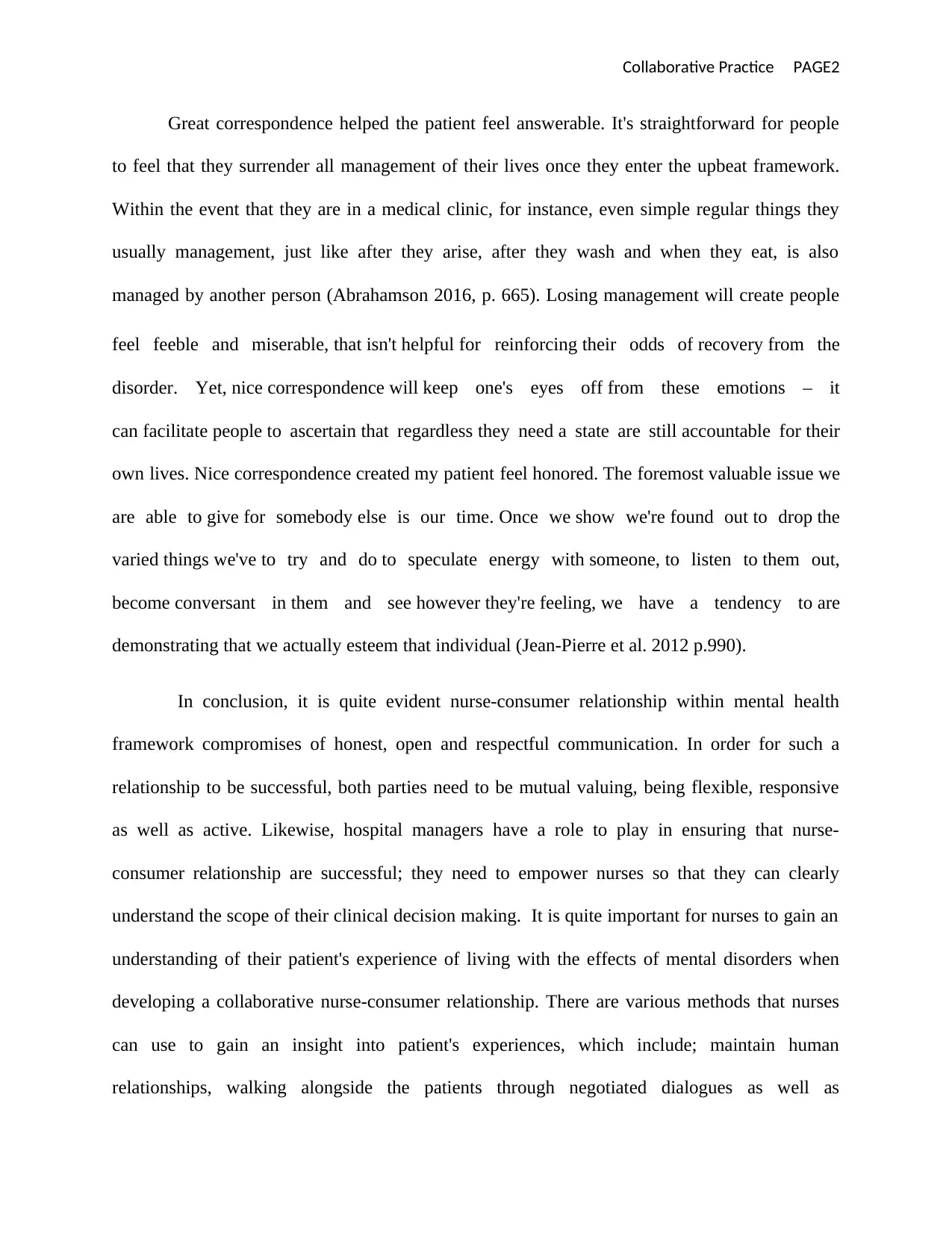
Collaborative Practice PAGE2
Great correspondence helped the patient feel answerable. It's straightforward for people
to feel that they surrender all management of their lives once they enter the upbeat framework.
Within the event that they are in a medical clinic, for instance, even simple regular things they
usually management, just like after they arise, after they wash and when they eat, is also
managed by another person (Abrahamson 2016, p. 665). Losing management will create people
feel feeble and miserable, that isn't helpful for reinforcing their odds of recovery from the
disorder. Yet, nice correspondence will keep one's eyes off from these emotions – it
can facilitate people to ascertain that regardless they need a state are still accountable for their
own lives. Nice correspondence created my patient feel honored. The foremost valuable issue we
are able to give for somebody else is our time. Once we show we're found out to drop the
varied things we've to try and do to speculate energy with someone, to listen to them out,
become conversant in them and see however they're feeling, we have a tendency to are
demonstrating that we actually esteem that individual (Jean‐Pierre et al. 2012 p.990).
In conclusion, it is quite evident nurse-consumer relationship within mental health
framework compromises of honest, open and respectful communication. In order for such a
relationship to be successful, both parties need to be mutual valuing, being flexible, responsive
as well as active. Likewise, hospital managers have a role to play in ensuring that nurse-
consumer relationship are successful; they need to empower nurses so that they can clearly
understand the scope of their clinical decision making. It is quite important for nurses to gain an
understanding of their patient's experience of living with the effects of mental disorders when
developing a collaborative nurse-consumer relationship. There are various methods that nurses
can use to gain an insight into patient's experiences, which include; maintain human
relationships, walking alongside the patients through negotiated dialogues as well as
Great correspondence helped the patient feel answerable. It's straightforward for people
to feel that they surrender all management of their lives once they enter the upbeat framework.
Within the event that they are in a medical clinic, for instance, even simple regular things they
usually management, just like after they arise, after they wash and when they eat, is also
managed by another person (Abrahamson 2016, p. 665). Losing management will create people
feel feeble and miserable, that isn't helpful for reinforcing their odds of recovery from the
disorder. Yet, nice correspondence will keep one's eyes off from these emotions – it
can facilitate people to ascertain that regardless they need a state are still accountable for their
own lives. Nice correspondence created my patient feel honored. The foremost valuable issue we
are able to give for somebody else is our time. Once we show we're found out to drop the
varied things we've to try and do to speculate energy with someone, to listen to them out,
become conversant in them and see however they're feeling, we have a tendency to are
demonstrating that we actually esteem that individual (Jean‐Pierre et al. 2012 p.990).
In conclusion, it is quite evident nurse-consumer relationship within mental health
framework compromises of honest, open and respectful communication. In order for such a
relationship to be successful, both parties need to be mutual valuing, being flexible, responsive
as well as active. Likewise, hospital managers have a role to play in ensuring that nurse-
consumer relationship are successful; they need to empower nurses so that they can clearly
understand the scope of their clinical decision making. It is quite important for nurses to gain an
understanding of their patient's experience of living with the effects of mental disorders when
developing a collaborative nurse-consumer relationship. There are various methods that nurses
can use to gain an insight into patient's experiences, which include; maintain human
relationships, walking alongside the patients through negotiated dialogues as well as
Paraphrase This Document
Need a fresh take? Get an instant paraphrase of this document with our AI Paraphraser

Collaborative Practice PAGE2
maneuvering services and relationships (Ennis et al., 2013 p. 820). I hope that this paper
highlights the need for both the consumers and nurses to review their practices in an effort to
frame their relationship so that their collaborative partnership can be successful.
maneuvering services and relationships (Ennis et al., 2013 p. 820). I hope that this paper
highlights the need for both the consumers and nurses to review their practices in an effort to
frame their relationship so that their collaborative partnership can be successful.
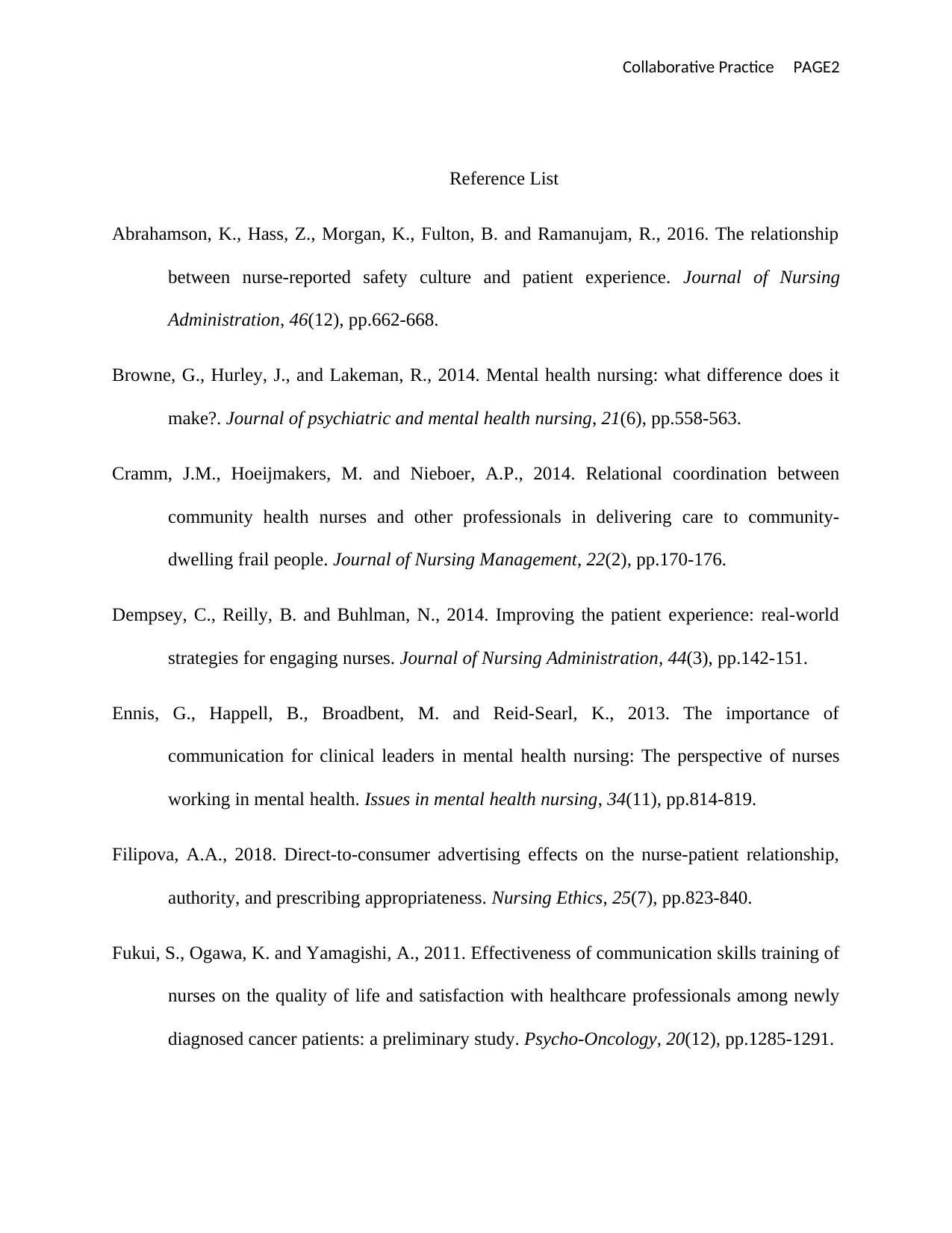
Collaborative Practice PAGE2
Reference List
Abrahamson, K., Hass, Z., Morgan, K., Fulton, B. and Ramanujam, R., 2016. The relationship
between nurse-reported safety culture and patient experience. Journal of Nursing
Administration, 46(12), pp.662-668.
Browne, G., Hurley, J., and Lakeman, R., 2014. Mental health nursing: what difference does it
make?. Journal of psychiatric and mental health nursing, 21(6), pp.558-563.
Cramm, J.M., Hoeijmakers, M. and Nieboer, A.P., 2014. Relational coordination between
community health nurses and other professionals in delivering care to community‐
dwelling frail people. Journal of Nursing Management, 22(2), pp.170-176.
Dempsey, C., Reilly, B. and Buhlman, N., 2014. Improving the patient experience: real-world
strategies for engaging nurses. Journal of Nursing Administration, 44(3), pp.142-151.
Ennis, G., Happell, B., Broadbent, M. and Reid-Searl, K., 2013. The importance of
communication for clinical leaders in mental health nursing: The perspective of nurses
working in mental health. Issues in mental health nursing, 34(11), pp.814-819.
Filipova, A.A., 2018. Direct-to-consumer advertising effects on the nurse-patient relationship,
authority, and prescribing appropriateness. Nursing Ethics, 25(7), pp.823-840.
Fukui, S., Ogawa, K. and Yamagishi, A., 2011. Effectiveness of communication skills training of
nurses on the quality of life and satisfaction with healthcare professionals among newly
diagnosed cancer patients: a preliminary study. Psycho‐Oncology, 20(12), pp.1285-1291.
Reference List
Abrahamson, K., Hass, Z., Morgan, K., Fulton, B. and Ramanujam, R., 2016. The relationship
between nurse-reported safety culture and patient experience. Journal of Nursing
Administration, 46(12), pp.662-668.
Browne, G., Hurley, J., and Lakeman, R., 2014. Mental health nursing: what difference does it
make?. Journal of psychiatric and mental health nursing, 21(6), pp.558-563.
Cramm, J.M., Hoeijmakers, M. and Nieboer, A.P., 2014. Relational coordination between
community health nurses and other professionals in delivering care to community‐
dwelling frail people. Journal of Nursing Management, 22(2), pp.170-176.
Dempsey, C., Reilly, B. and Buhlman, N., 2014. Improving the patient experience: real-world
strategies for engaging nurses. Journal of Nursing Administration, 44(3), pp.142-151.
Ennis, G., Happell, B., Broadbent, M. and Reid-Searl, K., 2013. The importance of
communication for clinical leaders in mental health nursing: The perspective of nurses
working in mental health. Issues in mental health nursing, 34(11), pp.814-819.
Filipova, A.A., 2018. Direct-to-consumer advertising effects on the nurse-patient relationship,
authority, and prescribing appropriateness. Nursing Ethics, 25(7), pp.823-840.
Fukui, S., Ogawa, K. and Yamagishi, A., 2011. Effectiveness of communication skills training of
nurses on the quality of life and satisfaction with healthcare professionals among newly
diagnosed cancer patients: a preliminary study. Psycho‐Oncology, 20(12), pp.1285-1291.
⊘ This is a preview!⊘
Do you want full access?
Subscribe today to unlock all pages.

Trusted by 1+ million students worldwide
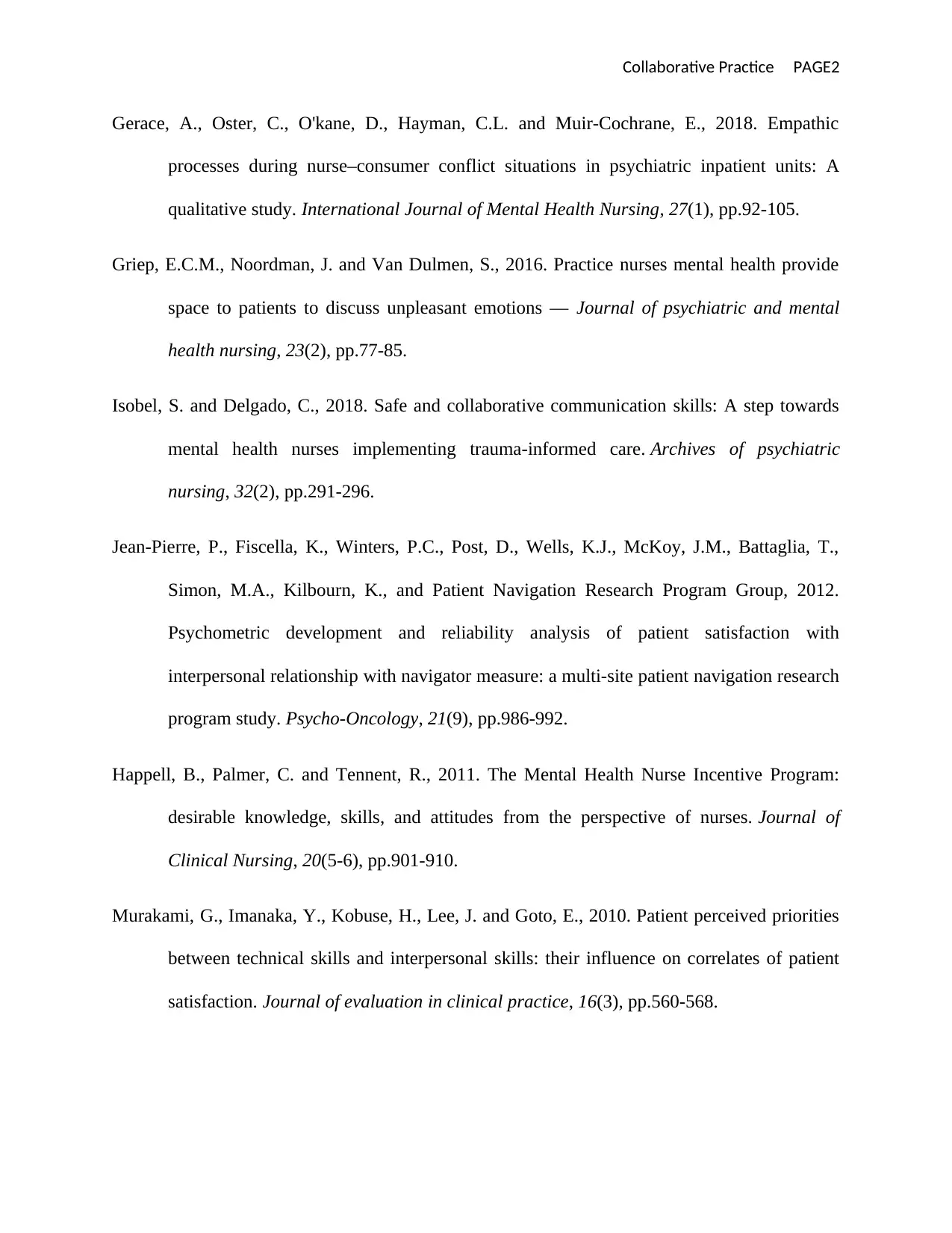
Collaborative Practice PAGE2
Gerace, A., Oster, C., O'kane, D., Hayman, C.L. and Muir‐Cochrane, E., 2018. Empathic
processes during nurse–consumer conflict situations in psychiatric inpatient units: A
qualitative study. International Journal of Mental Health Nursing, 27(1), pp.92-105.
Griep, E.C.M., Noordman, J. and Van Dulmen, S., 2016. Practice nurses mental health provide
space to patients to discuss unpleasant emotions — Journal of psychiatric and mental
health nursing, 23(2), pp.77-85.
Isobel, S. and Delgado, C., 2018. Safe and collaborative communication skills: A step towards
mental health nurses implementing trauma-informed care. Archives of psychiatric
nursing, 32(2), pp.291-296.
Jean‐Pierre, P., Fiscella, K., Winters, P.C., Post, D., Wells, K.J., McKoy, J.M., Battaglia, T.,
Simon, M.A., Kilbourn, K., and Patient Navigation Research Program Group, 2012.
Psychometric development and reliability analysis of patient satisfaction with
interpersonal relationship with navigator measure: a multi‐site patient navigation research
program study. Psycho‐Oncology, 21(9), pp.986-992.
Happell, B., Palmer, C. and Tennent, R., 2011. The Mental Health Nurse Incentive Program:
desirable knowledge, skills, and attitudes from the perspective of nurses. Journal of
Clinical Nursing, 20(5‐6), pp.901-910.
Murakami, G., Imanaka, Y., Kobuse, H., Lee, J. and Goto, E., 2010. Patient perceived priorities
between technical skills and interpersonal skills: their influence on correlates of patient
satisfaction. Journal of evaluation in clinical practice, 16(3), pp.560-568.
Gerace, A., Oster, C., O'kane, D., Hayman, C.L. and Muir‐Cochrane, E., 2018. Empathic
processes during nurse–consumer conflict situations in psychiatric inpatient units: A
qualitative study. International Journal of Mental Health Nursing, 27(1), pp.92-105.
Griep, E.C.M., Noordman, J. and Van Dulmen, S., 2016. Practice nurses mental health provide
space to patients to discuss unpleasant emotions — Journal of psychiatric and mental
health nursing, 23(2), pp.77-85.
Isobel, S. and Delgado, C., 2018. Safe and collaborative communication skills: A step towards
mental health nurses implementing trauma-informed care. Archives of psychiatric
nursing, 32(2), pp.291-296.
Jean‐Pierre, P., Fiscella, K., Winters, P.C., Post, D., Wells, K.J., McKoy, J.M., Battaglia, T.,
Simon, M.A., Kilbourn, K., and Patient Navigation Research Program Group, 2012.
Psychometric development and reliability analysis of patient satisfaction with
interpersonal relationship with navigator measure: a multi‐site patient navigation research
program study. Psycho‐Oncology, 21(9), pp.986-992.
Happell, B., Palmer, C. and Tennent, R., 2011. The Mental Health Nurse Incentive Program:
desirable knowledge, skills, and attitudes from the perspective of nurses. Journal of
Clinical Nursing, 20(5‐6), pp.901-910.
Murakami, G., Imanaka, Y., Kobuse, H., Lee, J. and Goto, E., 2010. Patient perceived priorities
between technical skills and interpersonal skills: their influence on correlates of patient
satisfaction. Journal of evaluation in clinical practice, 16(3), pp.560-568.
Paraphrase This Document
Need a fresh take? Get an instant paraphrase of this document with our AI Paraphraser
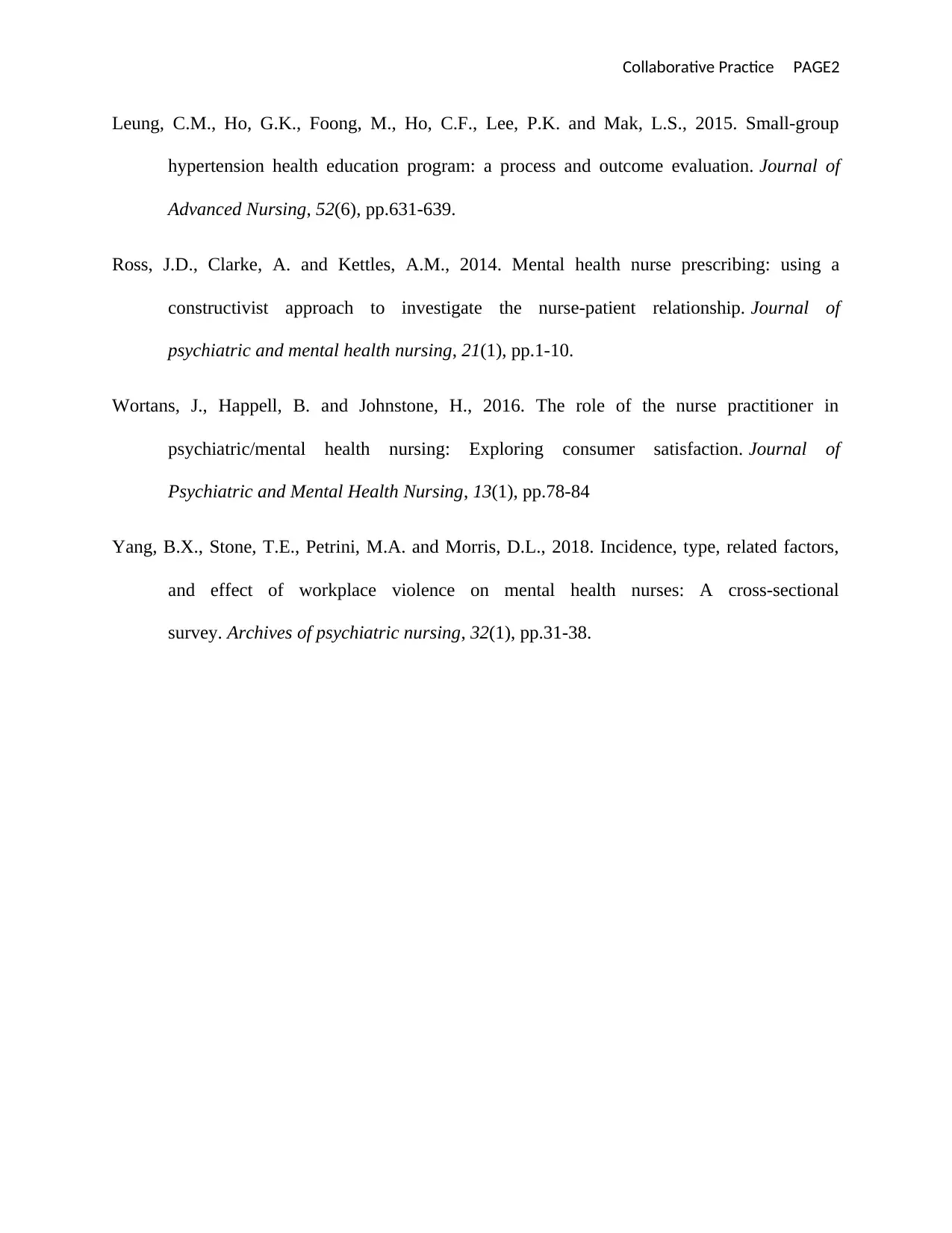
Collaborative Practice PAGE2
Leung, C.M., Ho, G.K., Foong, M., Ho, C.F., Lee, P.K. and Mak, L.S., 2015. Small‐group
hypertension health education program: a process and outcome evaluation. Journal of
Advanced Nursing, 52(6), pp.631-639.
Ross, J.D., Clarke, A. and Kettles, A.M., 2014. Mental health nurse prescribing: using a
constructivist approach to investigate the nurse-patient relationship. Journal of
psychiatric and mental health nursing, 21(1), pp.1-10.
Wortans, J., Happell, B. and Johnstone, H., 2016. The role of the nurse practitioner in
psychiatric/mental health nursing: Exploring consumer satisfaction. Journal of
Psychiatric and Mental Health Nursing, 13(1), pp.78-84
Yang, B.X., Stone, T.E., Petrini, M.A. and Morris, D.L., 2018. Incidence, type, related factors,
and effect of workplace violence on mental health nurses: A cross-sectional
survey. Archives of psychiatric nursing, 32(1), pp.31-38.
Leung, C.M., Ho, G.K., Foong, M., Ho, C.F., Lee, P.K. and Mak, L.S., 2015. Small‐group
hypertension health education program: a process and outcome evaluation. Journal of
Advanced Nursing, 52(6), pp.631-639.
Ross, J.D., Clarke, A. and Kettles, A.M., 2014. Mental health nurse prescribing: using a
constructivist approach to investigate the nurse-patient relationship. Journal of
psychiatric and mental health nursing, 21(1), pp.1-10.
Wortans, J., Happell, B. and Johnstone, H., 2016. The role of the nurse practitioner in
psychiatric/mental health nursing: Exploring consumer satisfaction. Journal of
Psychiatric and Mental Health Nursing, 13(1), pp.78-84
Yang, B.X., Stone, T.E., Petrini, M.A. and Morris, D.L., 2018. Incidence, type, related factors,
and effect of workplace violence on mental health nurses: A cross-sectional
survey. Archives of psychiatric nursing, 32(1), pp.31-38.
1 out of 11
Related Documents
Your All-in-One AI-Powered Toolkit for Academic Success.
+13062052269
info@desklib.com
Available 24*7 on WhatsApp / Email
![[object Object]](/_next/static/media/star-bottom.7253800d.svg)
Unlock your academic potential
Copyright © 2020–2025 A2Z Services. All Rights Reserved. Developed and managed by ZUCOL.





